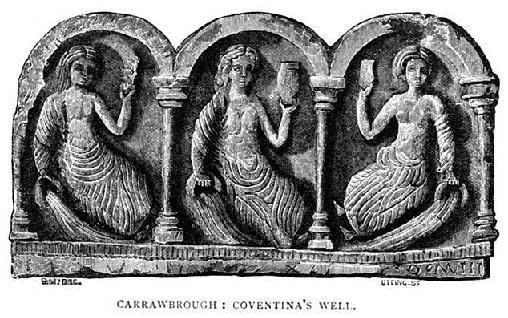Post by bluefedish on Jul 8, 2007 19:56:46 GMT -5
Coventina was a Romano-British goddess of wells and springs. She is known from multiple inscriptions at one site in Northumberland county of the United Kingdom, an area surrounding a wellspring near Carrawburgh on Hadrian's Wall. It is possible that other inscriptions, two from Hispania and one from Narbonensis, refer to Coventina, but this is uncertain and disputed.
Location & Dating:
Dedications to Coventina and votive deposits were found in a walled area which had been built to contain the output of a spring now called "Coventina's Well". The well and the walled area surrounding it are nearby the site variously referred to as Procolita, Brocolitia, or Brocolita, once a Roman fort and settlement on Hadrian's Wall. The remains of a Roman Mithraeum and Nymphaeum are also found near the site.
The site near Coventina's Well was excavated by British archaeologist, John Clayton, in 1876. The date of the wall at Coventina's Well is uncertain, but some have theorized that it was built sometime after the completion of the Roman fort (dated between the years 128 and 133). Since Hadrian's Wall does not deviate to avoid the well, this may suggest that the boundary wall around the well was built some time after in order to control the flow of water in a marshy area.
Evidence from coin hoards and stones which covered them and those also blocking the well suggest a fairly abrupt end around 388, perhaps due to events linked to anti-Pagan edicts of Theodosius I.
Statues:
Excavation of the site revealed several inscribed altars, some with depictions of Coventina in typical Roman nymph form; two are shown here. On one, Coventina is depicted in triple form, or alternatively has two attendants.
Excavation also revealed a large quantity of coinage, from early Augustan coins to those of the late 4th century, and other votive objects such as brooches, rings, pins, glassware, and pottery. These are assumed to be votive offerings due to the quantity discovered in a single location.

Selected Source:
en.wikipedia.org/wiki/Coventina
Location & Dating:
Dedications to Coventina and votive deposits were found in a walled area which had been built to contain the output of a spring now called "Coventina's Well". The well and the walled area surrounding it are nearby the site variously referred to as Procolita, Brocolitia, or Brocolita, once a Roman fort and settlement on Hadrian's Wall. The remains of a Roman Mithraeum and Nymphaeum are also found near the site.
The site near Coventina's Well was excavated by British archaeologist, John Clayton, in 1876. The date of the wall at Coventina's Well is uncertain, but some have theorized that it was built sometime after the completion of the Roman fort (dated between the years 128 and 133). Since Hadrian's Wall does not deviate to avoid the well, this may suggest that the boundary wall around the well was built some time after in order to control the flow of water in a marshy area.
Evidence from coin hoards and stones which covered them and those also blocking the well suggest a fairly abrupt end around 388, perhaps due to events linked to anti-Pagan edicts of Theodosius I.
Statues:
Excavation of the site revealed several inscribed altars, some with depictions of Coventina in typical Roman nymph form; two are shown here. On one, Coventina is depicted in triple form, or alternatively has two attendants.
Excavation also revealed a large quantity of coinage, from early Augustan coins to those of the late 4th century, and other votive objects such as brooches, rings, pins, glassware, and pottery. These are assumed to be votive offerings due to the quantity discovered in a single location.

Selected Source:
en.wikipedia.org/wiki/Coventina



